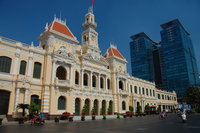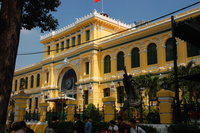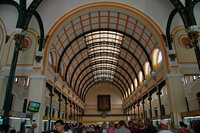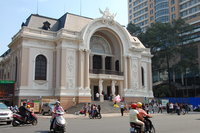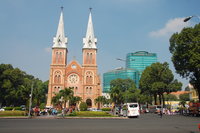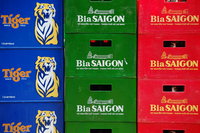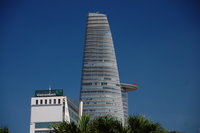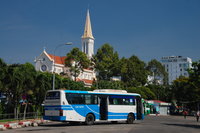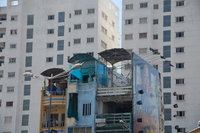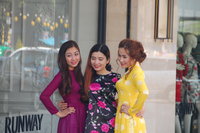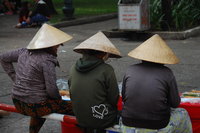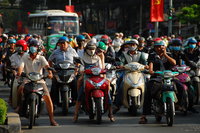Saigon
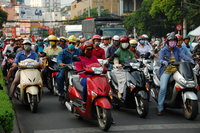
Steve had always wanted to come here (although could come up with no rational reason why), but having spent much time recently in the countryside and small towns, the visit had begun to loom rather ominously on the itinerary. Noise, hassle, expense; all the big city stuff. As it happens, it seems that much of the city is not of any interest to the tourist so that made the whole project rather more manageable.
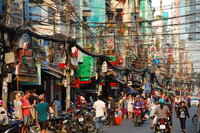
The official name for this place is Ho Chi Minh City, which represents the North's attempt to stamp their new, post 1975, communist identity on the southern powerhouse that was Saigon. Many of the locals still refer to their city as Saigon (actually Sài Gòn) and we shall too because it is much less ungainly. The airport code is SGN and the railway station still prominently displays the name Sài Gòn as do many of the road signs, so it may be a while before Uncle Ho completely usurps the place. After 40 years of communist rule, this once decadent and rampantly capitalist southern city is now...decadent and rampantly capitalist. Free enterprise is everywhere, high-rise buildings are being thrown up all over the place, they are building a spanking new metro system, everyone drinks beer and does pretty much as they please. Today, the city contains some 9 million people (all of whom seem to own a motorbike), which makes it by far the largest city in Vietnam.
We visited the Củ Chi (pronounced Gucci) tunnel complex on the outskirts of Saigon (i.e. 50km from our downtown hotel). This area was occupied by Viet Cong guerillas whilst the Americans were in Saigon. In fact, the tunnels reached into the city and, in the opposite direction, to the Cambodian border. This was also the VC's base during the Tết Offensive in 1968.
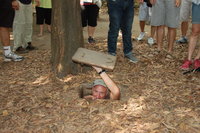
There is a 121km tunnel complex at Củ Chi although only a very small section is open to the public. Additionally, it is rumoured that there may be thousands of kilometers of tunnels in the area and that the Vietnamese military may have records of some or all of it. The public is not privy to this information. If they are keeping this as a strategic military asset, they may get a shock when they find the average Vietnamese is now much wider (and probably taller) than when the tunnels were last used in anger!
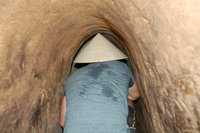
There are some interesting displays at Củ Chi about how the VC built traps and conducted psy-ops against the Americans; for example by putting snakes in the tunnels as a deterrent. They also made sure the tunnel entrances were too small for US soldiers. Other tricks include commandeering unexploded ordnance and re-engineering it to build bombs and mines to disable US tanks as they didn't have such weapons themselves. Visitors have the "opportunity" to shuffle down a 100m long stretch of the tunnel system which is poorly lit and very hot. On the plus side, there are no snakes these days!
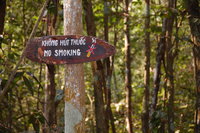
Củ Chi is in a jungle area just as it was during the war. However, it is not the same jungle, since that was razed to the ground by the Americans as they carried out unrestricted carpet bombing from B52s in an attempt to destroy the tunnels. They didn't want to use Agent Orange here due to the proximity of US troops. Nowadays, the jungle is peppered with signs saying "No Smoking", which is rather ironic considering the napalming the place got.
At the end of the tour, one has the opportunity to have a go on some of the commandeered US weapons that are still functioning forty years on. The visitor has to purchase the bullets - the "menu" quotes prices per bullet. Bullets for the M60 machine gun, for example, cost £1 each, but you have to buy a minimum of ten. Given that about 600 per minute come out of the business end when you pull the trigger, this would be a costly (if amusing) choice. We didn't bother, both having fired plenty of weapons in the past (and because we need to eat for the next month). The fact that there was a firing range on site did add a level of realism to the entire visit though as our guide's talk was interrupted regularly by the sound of sustained gun fire (and the even more sustained wails of now very poor tourists).
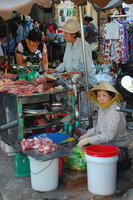
butchers
As a precursor to the Củ Chi visit, we went to the so called War Remnants museum in downtown Saigon. It contains some bits of scrap ordnance and weapons from the war plus some US tanks/aircraft that the "brave and victorious comrades" destroyed. In fact the entire place is a homage to the bravery and spirit of the communists in the face of the "imperialist butchers". Victor's prerogative. In the main, though, the museum is made up of photographs depicting the horrors inflicted on the Vietnamese by the US during the war. In particular the effects of Dioxin rich Agent Orange on subsequent generations that are still being felt today. The vast majority of visitors to the museum that we saw seemed to feel the need to photograph the disfigured and disabled bodies depicted. Not sure why. If even half of what we read is true, then this was an horrific campaign.
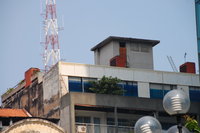
There are a number of other landmark places to go and see in town. Our guide book helpfully provides a walking tour that takes in these sights. However, since one of the recommended places to visit was a roundabout, we decided to adapt. Also, it is furnace hot on the streets so there is a limit to the amount of trudging we want to do in one day.
One particularly iconic landmark that Steve was keen to see was a lift shaft. This is the small structure on the top of a building at 22 Lý Tự Trọng Street. It was the subject of Hubert van Es's famous photograph taken during the "Fall of Saigon". The photo is often believed to be of the roof of the American Embassy, but in fact it is simply an apartment block that was being used by the Americans including the CIA. Nowadays, there is no helicopter on the top.
Some of the other places on our walking tour included City Hall, the Central Post Office (honest), the opera house and the cathedral. The post office in particular was very impressive. All these fine old buildings are hemmed in on all sides by modern constructions, which is testament to the rampant growth of the city and is actually a characteristic in its own right. Hopefully these heritage buildings will not become completely lost to progress.
We visited the Central Market on the recommendation of our guide book, but it is a strangely sanitized place. Not that any markets we have seen have been dirty, but this one was organised, tidy and quiet, unlike the markets we have seen all over the country. A different market we went to had more of a "street" feel to it including the sale of the usual fish and meat products. We observed a woman on a meat counter shaving a pig's leg (which sounds like a bit of a euphemism). Perhaps she thought we looked a bit daft, since she mimed an animal walking in case we didn't recognise a leg - the trotter on one end was the real give away.
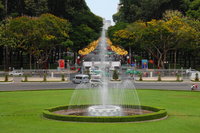
The Tết festival (Vietnamese lunar New Year) is also rapidly approaching and, certainly in Saigon, preparations continue apace. With a mere two weeks to go, yellow flowers are appearing everywhere and stages are being constructed. We have heard various stories about how this festival will affect us, but it is certainly shaping up to be a big deal for the locals.
As we alluded at the start of this entry, there is not actually a lot to do in this city. There is a large backpacker community in District 1 and this manifests itself in all night drinking and "partying", that gels very well with the Vietnamese proclivity for hideously over-amplified dance music. After the peace and quiet of Cát Tiên, sleep did not come easily at our hotel in this area. That is not to say we did not enjoy our stay here and we spent a few evenings sitting outside a bar watching the traffic craziness and competing to spot the most overloaded motorcycle. However, when we return to catch our flight home, we will be staying elsewhere.
As we said at the start of this trip, the convoluted itinerary was designed to try and skip the bad weather in the central region. We are off there next, so we will see whether the best laid plans pan out. Stick around to find out.
Some Pictures
